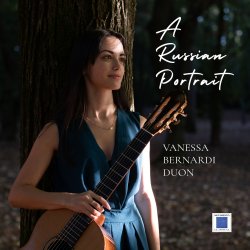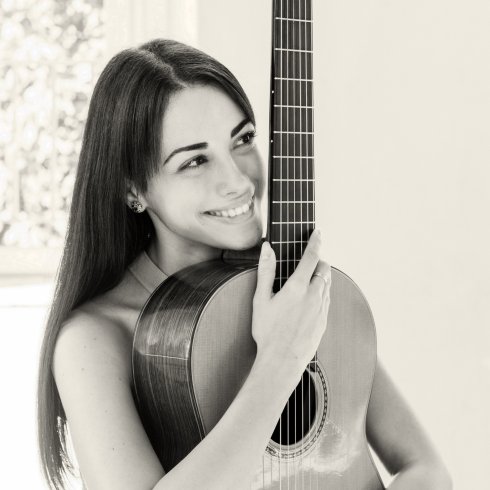

A Russian Portrait
A Russian Portrait
The album contains an interesting and relatively unknown programme of originai compositions by Russian composers. The first part, as a solo, is entrusted to Vanessa Bernardi; Nicholas Nebuloni joins her in the second part, forming the DuOn, winner of the competition 'La tua idea'.
The soul of the Russian people emerges clearly !rom the first notes, revealing its unmistakable characteristics of viscera!, passionale and engaging expression. The troubled history of this nation is reflected in the painful musical expression, where every listener can perceive the strong feeling of melancholy as a universal existential condition. From the versatile Sergey Rudnev (1955), active as a performer, composer and teacher, two pieces are performed here: the first, White Grand Piano, dedicateci to the guitarist Irina Kulikova, was composed in a jazz café in Hollywood. lt features a poignant and romantic melody with wide pitch excursions and sweet harmonies typical of the best songwriting.
The second track, The Old Lime Tree, based on a traditional Russian song, has great narrative power. The melancholy period of the old lime tree, in the sombre key of B minor, is illuminateci by some flashes in major. The elegiac theme is then restateci in the low register and accompanied by a free countermelody. A tormented and stormy episode then reaches the highest register of the guitar. Rapid arpeggios then lead to the evocation of the wind in the leaves of the tree, with a whispered fingertip rasgueado. The piece ends with a poignant conclusion, embellished with delicate timbrai effects.
Ballata per Elena Bellissima, composed in 1994, is presented by the precocious and award-winning Viktor Kozlov (1958). The melody starts !rom the high register and returns towards the initial register.
In its third appearance, the melodie "hook" has the audacity to go even higher, creating amazement in the listener. The short centrai episode, rougher and with darker hues, presents disorienting modulations to distant tones. The reprise contains a rapid cadenza that leads back to the hook, this time underlined by full and solemn chords; the conclusion, with a descending counterpoint lor three voices, leads back to the sweetness of the opening.
Composer and guitarist Nikita Koshkin (1956) is among the best known and most performed contemporary composers. His visionary style achieves a synthesis between popular music and the historical avant-gardes of the twentieth century, especially Russian composers. His music often draws inspiration !rom programmatic cues,
with a particular fondness lor fairy-tale and fantasy plots.
The two pieces taken !rom the Elves Suite, inspired by the mythological Norse beings, are no exception and represent two apposite souls of this series of sound sketches.
Melody is a languid slow waltz, in which the main melody lingers on the different harmonic colours of the same repeated note. A centrai section presents a serene melody thai soars upwards, and then surprises us with melodie chromatisms and unexpected harmonies. A short monodie recitative, based on disillusioned descending glissandi, brings us back to the reprise of the initial theme, which vanishes in an ethereal-sounding coda in the extreme register of the instrument.
Galop, the last piece of the Suite, is a boisterous dance, "dirtied" by burlesque chromatisms and dissonances. The unbridled and enthralling pace is enlivened by some unsettling metrics. The guitar writing is perfectly idiomatic and succeeds in exploiting the positions of the instrument to create originai musical solutions.
The Cambridge Suite is a collection of five pieces tor two guitars.
The initial Lullaby is a delicate lullaby, which howeverpresents skilful modulations to distant tones and a rich interpenetration of the two guitar parts.
The Tennis Waltz is an ironie dance, whose main theme plays on the contrast between a traditional accompaniment and a mischievously dissonant high-pitched melody. Some hoquetus (sudden alternations between the two guitars) create effects of spatial displacement of the sound and overlapping of resonances; effects that enhance the twelve-string formation.
Ragtime is a casual homage to the father of the genre, Scott Joplin, who is not only imitateci in style, but also mentioned at the end of the song through the incipit of The Entertainer. The piece initially presents two themes, with typical syncopated melodies superimposed on a regular march tempo. Alter which the two themes are superimposed, creating an interesting effect of the ca-presence of different musical ideas.
The Ballaci is the romantic heart of the Suite. The evocative introduction, based on rich chords and chromatic movements, gives way to the ballaci theme , consisting of descending melodie intervals; the reference to the ancient Canto dei battellieri del Volga is spontaneous. The accornpaniment, which wearily repeats a chordal ostinato, evokes the fatigue of the boatmen in dragging the boats against the current.
The final Hurnoresque returns to grotesque atrnospheres, combining folk-style themes with biting and strident harmonies. The main theme alternates between the Doric and Phrygian modes, creating a suggestive reminder of distant worlds. The musical plot, full of fun effect games, gets heavier and heavier as you get closer to the end, and then concludes surprisingly in a light and cheeky way.
Alexander lvanov Kramskoi (1912-1973) was bewitched as a boy by the magie of Segovia, which led him to abandon the violin to devote himself to the guitar. The Variations on a Russian Romance of his immense guitar production are performed here.
The theme rises hopefully but suddenly folds back on itself, drawing a suffering and disconsolate state of mind. lt is this gloomy atmosphere that pervades Kramskoi's variations, slightly lifted by the dance rhythm of the first varia tion. The short cycle of variations ends with a poignant tremolo in the extreme registe, of the instrument.
By Konstantin Vassiliev (1970), the youngest of the authors in the program, two compositions are performed that well represent the two souls of the cornposer: the one linked to the Russian tradition (in the piece Elegie) and the one instead which is expressed with a more current musical style and updated (like the Two Russian Pieces). The Elegie tor solo guitar, !rom the Three Lyric Pieces published in 2012, is a heartfelt tribute to Sergej
Rachmaninov. The nostalgie first part features bittersweet modal interchanges; the melody then ascends to the high register with natural singability. The second part, an agitateci perpetuum mobile, stops on enigmatic suspended harmonies, illuminateci by harmonic sounds. The reprise is aggravateci by more powerful harmonies and descending chromatic counterpoints, while the secondary theme reappears in the high register, almost like an oasis ot salvation. The short coda recalls the initial theme in a hint of a two-voice canon.
The first of the Two Russian Pieces lor two guitars, Vision, exhibits a pathetic melody with a traditional tlavour, which is subsequently elaborateci through dense counterpoints ot considerable rhythmic complexity.
The Dance of the Skomorokhs, on the other hand, is inspired by the minstrels of mediaeval Russia, versatile street
artists skilled in acting, singing, dancing and playing instruments. lt is a wild dance with unsettling rhythmic accentuations and a virtuosic intertwining ot voices. There is no desire here to imitate the musical style ot the Russian Middle Ages, which, however, is evoked, preferring to drop the discourse in a contemporary style,sometimes jazzy.
The only non-contemporary composer, who in fact lived between the end ot the eighteenth century and the first hall of the nineteenth century, Andrei Sychra (1773? - 1850) is an almost legendary figure in the panorama of Russian music tor plucked strings. Believed to be the inventar ot the Russian seven-string guitar, he was also acclaimed virtuoso of the harp and the legendary torban.
The piece recorded here, Variations on a Russian Theme, consists of an evocative theme in D minor followed by three short variations. The writing, adapted to the hexachord guitar, recalls the author's compositional style in an exemplary way, often based on a sound texture made up of large arpeggios.


Vanessa Bernardi
In October 2023, Vanessa Bernardi will obtain her two-year second-level diploma in classical guitar at the A. Buzzolla Conservatory in Adria under the guidance of Maestro Giulio Tampalini. This follows her achievement of a three-year first-level diploma with the highest grades and honours in October 2021. That same year, she also earned a bachelor's degree in History and Protection of Musical Artistic Heritage from the University of Padua (thesis title: "Music in the Time of Covid-19: Musical Initiatives and Distance Education"). Vanessa began studying classical guitar at the age of ten at the Scuola Musicale C. Moser in Pergine Valsugana and continued her education at the Liceo Musicale in Trento and the ‘F.A. Bonporti’ Conservatory in the same city, under the guidance of Norma Lutzemberger. During her artistic training, she participated in several masterclasses with internationally renowned masters such as Adriano del Sal, Christian Saggese, Andrea Dieci, Emanuele Segre, Ricardo Barcelò, Anabel Montesinos, Luigi Attademo, Lorenzo Micheli, Matteo Mela, Marco Ramelli, Giacomo Susani, Gabriel Bianco, Alexandra Whittingham, Irina Kulikova, Marco Tamayo, and Lucia Pizzutel. With the latter, she successfully completed the guitar workshop "Methodological Pills" related to instrumental teaching themes. She has ranked in top positions in guitar interpretation contests both as a trio and solo performer. Notable contests include the "Cesare Lutzemberger" competition in Treviso, the "Val di Sole" competition, and the Guitar Master Lago D' Orta where she received a special prize. Recently, she won the "La tua idea" project competition sponsored by the Adria conservatory, allowing her to record two albums dedicated to Spanish and Russian repertoires both as a soloist and in a guitar duo with the record label “Movimento Classical”. She has performed as both a soloist and in duos at numerous concerts and prestigious venues, including Villa Roberti, the Filarmonico Theater in Piove di Sacco, Milan Cathedral, the International Guitar Festival of the A. Buzzolla Conservatory in Adria, and the Gaetano Marziali Academy in Seveso, among others.
